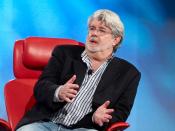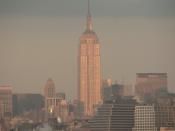"Star Wars" was arguably the first in a new breed of high concept, high budget sci-fi action films. It was directed by George Lucas and originally released in only a few cinemas in 1977. However, the buzz around the film grew, and it is now one of the highest grossing films of all time, and along with its sequels, prequels and re-mastered re-releases, has a large cult following. I feel this is because of Lucas` ability to engage the audience through careful use of sound and camera technique;
The use of the scrolling story in space sets up many audience expectations, that the action will be set in space, and that it will base around a struggle between the rebels and the Empire. Narration is a fairly formal method of exposition, linked to the old style fairytale format, preparing the audience for a classic narrative and easily recognizable characters, and expectation that is fulfilled throughout the film (Leia is the princess needing rescue, Vader the "baddie" and Han Solo is the knight and shining armour for example).
However, the traditional fairytale narrative also dictates that there should be a happy ending with all the loose ends tied up. This is not the case, for whilst the film ends on an up beat note, the ultimate threat of the Empire has not been neutralized, and has to be dealt with in a separate film.
The opening section begins with what appears to us to be a large space ship, flying in from the bottom of the screen at great speed, instantly creating the enigma of who it is moving away from and why they are being fired upon. The next thing we experience is a truly huge battle cruiser gently fly in from the same direction, dwarfing the one seen before.


